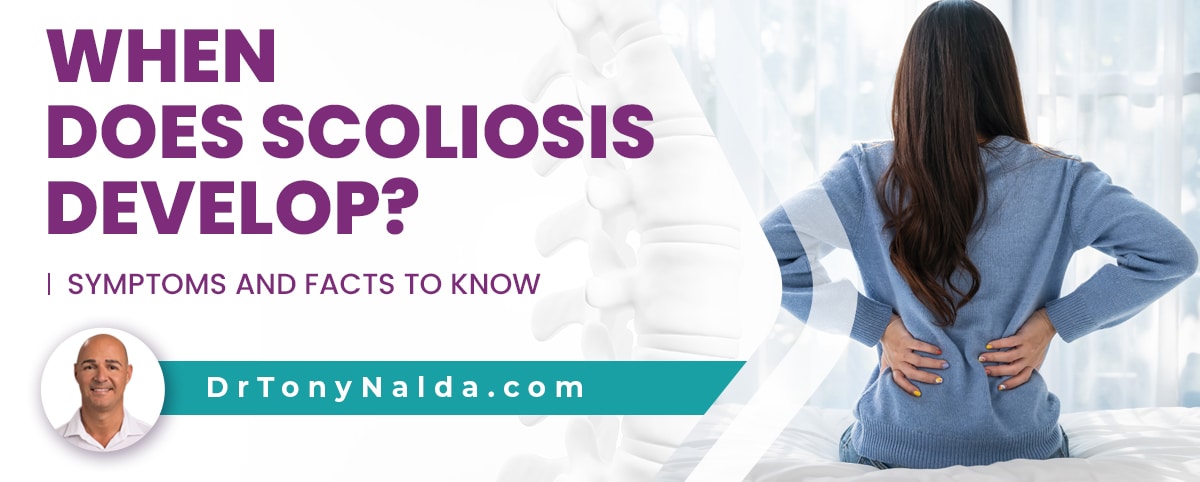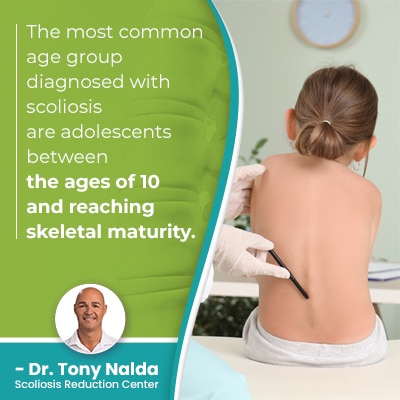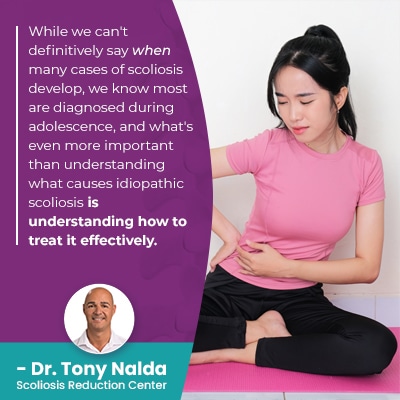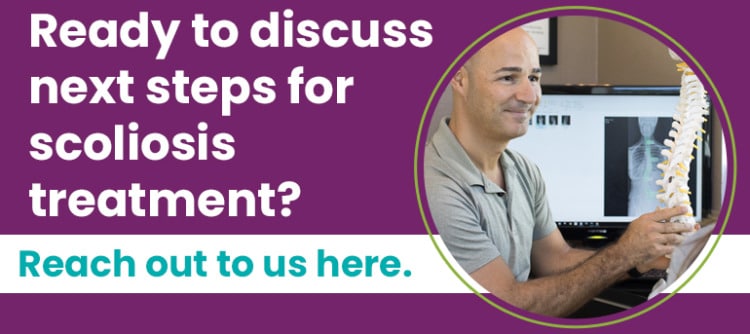When Does Scoliosis Develop? Symptoms and Facts to Know

In many cases, when scoliosis is diagnosed doesn’t indicate that’s when it developed. Scoliosis can start as mild but become moderate, severe, or very severe. Most of my patients are diagnosed with moderate scoliosis because the signs of mild scoliosis can be subtle, and it’s not until conditions progress that they become noticeable enough to lead to assessment.
No two cases of scoliosis are the same, and the condition doesn’t develop at a set time; in fact, we don’t know what causes most cases of scoliosis to develop initially, but we do know what makes it progress and how to treat it.
There is a lot we don’t know about how and why scoliosis develops, so let’s explore what we know, and what we don’t know, about causation.
Table of Contents
What Causes Scoliosis?
Scoliosis is a highly-prevalent spinal condition that causes an unnatural side to side curve to develop in the spine, and as a progressive condition, the nature of scoliosis is to get worse over time.
Scoliosis progressing means the size of the unnatural spinal curve is increasing and the condition is becoming more complex to treat.
When a case of scoliosis is first diagnosed, part of the process involves comprehensive assessment to further classify conditions.
An important classification point is condition type, and this is determined by causation; this is important to determine because when the cause is known, it has to be addressed as the condition's underlying cause.
If a condition's causation isn't addressed, only the condition's symptoms are being treated, but not their cause: the scoliosis itself.
So what causes scoliosis? In the majority of scoliosis cases, we don't know the initial cause, and this applies to the condition's most-common type: idiopathic scoliosis.
Idiopathic Scoliosis
 Approximately 80 percent of known cases are classified as idiopathic, meaning not clearly associated with a single-known cause.
Approximately 80 percent of known cases are classified as idiopathic, meaning not clearly associated with a single-known cause.
While we don't understand why idiopathic scoliosis develops initially, we know what makes it progress, and we know how to treat it effectively.
As we don't know the cause, the focus is on how to manage the condition effectively, and this means working towards counteracting its progressive nature.
Idiopathic scoliosis is thought to be multifactorial: caused by different variables, or combinations of variables, that change from one patient to the next.
Idiopathic scoliosis is the most common type to affect all ages, and while it's diagnosed most often in adolescents, adults are also affected.
So the most common age group diagnosed with scoliosis are adolescents between the ages of 10 and reaching skeletal maturity.
And what about scoliosis with known causes? When do these cases tend to develop?
Scoliosis With Known Causes
While most cases of scoliosis don't have known causes, but develop most often during adolescence, the remaining 20 percent of scoliosis cases are associated with known causes, and they develop at different times: neuromuscular scoliosis, degenerative scoliosis, and congenital scoliosis.
Neuromuscular scoliosis is caused by the presence of a larger neuromuscular condition like spina bifida, muscular dystrophy, or cerebral palsy, and the scoliosis develops as a complication of the larger neuromuscular condition.
So scoliosis develops after the larger condition, and as neuromuscular conditions disrupt communication between the brain, the spine, and the muscles that support the spine, my neuromuscular scoliosis patients can be the most difficult to treat.
Degenerative scoliosis is caused by natural age-related spinal degeneration, so most often develops in adults over the age of 45.
Degenerative scoliosis is also more common in females than males due to bone density and hormone changes related to menopause.
Congenital scoliosis has the most specific development time because babies are born with the condition; it's caused by a malformed spine that develops in utero.
Congenital scoliosis is a rare type, affecting 1 in 10,000.
So as you can see, there are many different types of scoliosis, and while we can't pinpoint when exactly idiopathic scoliosis develops, as it's most often diagnosed in adolescents, adolescent idiopathic scoliosis commonly develops around the age of 10.
Early Detection and Progression
As mentioned earlier, when scoliosis is diagnosed doesn't mean that it has recently developed.
In fact, in the majority of cases, scoliosis isn't diagnosed until progression has made the condition more noticeable.
So in most cases, conditions developed long before a diagnosis was reached; the best example of this is idiopathic scoliosis in adults.
The main type of scoliosis to affect adults is idiopathic, but these cases are interesting because they don't develop fresh in adulthood, but rather, these patients developed their scoliosis during adolescence, but were unaware.
It's a common scenario that childhood scoliosis can go unnoticed until skeletal maturity has been reached and growth stops; this is when scoliosis becomes a compressive condition and painful.
Compression is uneven pressure, and compression of the spine and its surrounding muscles and nerves is the main cause of condition-related pain.
Scoliosis isn't commonly painful for children because they are still growing, and the constant lengthening motion of growth counteracts the compressive force of the unnatural spinal curve.
There are never treatment guarantees, but with early detection and intervention, conditions are more responsive.
So while we can't definitively say when many cases of scoliosis develop, we know most are diagnosed during adolescence, and what's even more important than understanding what causes idiopathic scoliosis is understanding how to treat it effectively.
Proactive Scoliosis Treatment
Most scoliosis cases don't need surgical treatment, and the earliest signs of scoliosis in children are postural changes like uneven shoulders, uneven hips, an uneven waist, and the development of a rib cage arch.
As a child grows, the condition can progress and cause more noticeable changes to posture and movement.
In adults, the main sign of scoliosis is pain.
As curve progression occurs as a child grows, regardless of when the condition develops initially, the treatment response is the most important factor.
The best way to treat scoliosis is proactively because it means starting treatment as close to the time of diagnosis as possible, when conditions are at their mildest and most responsive.
It's important for patients to understand that if the spine twists and bends unnaturally, its effects can be felt throughout the body, and not just in and around the spine.
Examining a child's spine while they are bending forward places the spine in a highly-visible position, and any related trunk asymmetries are also more noticeable in this position.
Treatment Integration
 Proactive treatment works towards preventing progression, increasing effects, and the need for scoliosis surgery.
Proactive treatment works towards preventing progression, increasing effects, and the need for scoliosis surgery.
Here at the Scoliosis Reduction Center®, patients of all ages benefit from a proactive conservative treatment approach that combines the power of a corrective back brace, chiropractic care, physical therapy, scoliosis specific exercises, and rehabilitation.
Many adolescents require bracing that can help by pushing the spine into a healthier alignment, and chiropractic care works towards reducing the size of the unnatural spinal curve on a structural level.
Physical therapy and scoliosis specific exercise can help improve the spine's surrounding muscle strength and balance for more spinal support and stability, and rehabilitation also involves custom-prescribed exercises and stretches that can be performed from home so patients can continue to heal and stabilize their spines.
As an progressive condition, scoliosis treatment is about managing an ongoing condition for the best quality of life.
When symptoms of scoliosis first appear, it's important to understand that immediate assessment is necessary, and it's also important for patients to understand that the time of diagnosis doesn't mean the condition has just developed.
Conclusion
While most cases of scoliosis develop during adolescence, some condition types develop in utero, or are caused by age-related spinal degeneration, so develop after the age of 45.
Knowing scoliosis symptoms to watch for can lead to an early diagnosis, and knowing scoliosis risk factors can also help indicate when someone should be paying closer attention.
If another family member has been diagnosed, a family history is considered a risk factor that warrants regular check ups and scoliosis screening.
Most people who are diagnosed early and treat their conditions proactively can avoid spinal fusion surgery, and most children diagnosed have flexible spines that can be highly responsive.
A proactive treatment plan that's customized to address key patient/condition variables can help prevent mild curves from becoming severe scoliosis.
Effective treatment options can help prevent complications that are associated with untreated scoliosis including disruptions to lung function, cardiac and digestive issues.
Undiagnosed scoliosis in children can progress into adulthood and become painful, and the sooner an unhealthy spinal curvature is addressed, the better.
While it's beneficial to diagnose scoliosis early, the best time to start scoliosis treatment is always now, regardless of condition type, severity, or when it developed initially.
Dr. Tony Nalda
DOCTOR OF CHIROPRACTIC
After receiving an undergraduate degree in psychology and his Doctorate of Chiropractic from Life University, Dr. Nalda settled in Celebration, Florida and proceeded to build one of Central Florida’s most successful chiropractic clinics.
His experience with patients suffering from scoliosis, and the confusion and frustration they faced, led him to seek a specialty in scoliosis care. In 2006 he completed his Intensive Care Certification from CLEAR Institute, a leading scoliosis educational and certification center.
About Dr. Tony Nalda
 Ready to explore scoliosis treatment? Contact Us Now
Ready to explore scoliosis treatment? Contact Us Now





